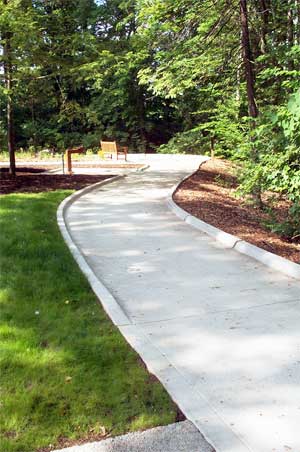Applications
 Pervious Paths
Pervious Paths
Although not a new technology (it was first used in 1852), pervious concrete is receiving renewed interest, partly because of federal clean water legislation. The high flow rate of water through a pervious concrete pavement allows rainfall to be captured and to percolate into the ground, reducing stormwater runoff, recharging groundwater, supporting sustainable construction, providing a solution for construction that is sensitive to environmental concerns, and helping owners comply with EPA stormwater regulations. This unique ability of pervious concrete offers advantages to the environment, public agencies, and building owners by controlling rainwater on-site and addressing stormwater runoff issues. This can be of particular interest in urban areas, or where land is very expensive. Depending on local regulations and environment, a pervious concrete pavement and its subbase may provide enough water storage capacity to eliminate the need for retention ponds, swales, and other precipitation runoff containment strategies. This provides for more efficient land use and is one factor that has led to a renewed interest in pervious concrete. Other applications that take advantage of the high flow rate through pervious concrete include drainage media for hydraulic structures, parking lots, tennis courts, greenhouses, and pervious base layers under heavy-duty pavements. Its high porosity also gives it other useful characteristics: it is thermally insulating (for example, in walls of buildings) and has good acoustical properties (for sound barrier walls).
Although pavements are the dominant application for pervious concrete in the U.S., it has also been used as a structural material for many years in Europe. Applications include walls for two-story houses, load-bearing walls for high-rise buildings (up to ten stories), infill panels for high-rise buildings, sea groins, roads, and parking lots. Table 1 below lists examples of applications for which pervious concrete has been used successfully.
All of these applications take advantage of the benefits of pervious concrete’s characteristics. However, to achieve these results, mix design and construction details must be planned and executed with care.

Low-volume pavements

Residential roads, alleys, and driveways
Sidewalks and pathways
Parking areas
Low water crossings
Tennis courts
Subbase for conventional concrete pavements
Patios
Artificial reefs
Slope stabilization
Well linings
Tree grates in sidewalks
Foundations/floors for greenhouses, fish hatcheries, aquatic amusement centers, and zoos
Hydraulic structures
Swimming pool decks
Pavement edge drains
Groins and seawalls
Noise barriers
Walls (including load-bearing)


